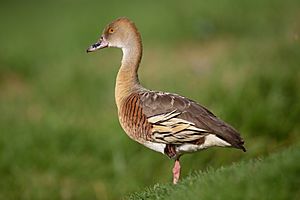Plumed whistling duck facts for kids
Quick facts for kids Plumed whistling duck |
|
|---|---|
 |
|
| New South Wales, Australia | |
| Conservation status | |
| Scientific classification | |
| Genus: |
Dendrocygna
|
| Species: |
eytoni
|
The plumed whistling duck (Dendrocygna eytoni) is a special type of whistling duck that lives and raises its young in Australia. It's also known as the grass whistling duck because it loves grassy areas. This duck is mostly brown with a long neck. It has cool, long feathers called plumes that stick out from its sides. Both male and female plumed whistling ducks look very much alike.
Contents
About Its Name
The plumed whistling duck was first described in 1838 by an English scientist named Thomas Campbell Eyton. The duck's scientific name, eytoni, was given to honor him!
Its other scientific name, Dendrocygna, comes from two old Greek words. Dendron means "tree," and kuknos (which became cygnus in Latin) means "swan." So, its name basically means "tree swan," even though it's a duck! People sometimes call it by other names too, like Eyton's plumed duck or red-legged whistler.
What Does It Look Like?
This duck is about 42 to 60 centimeters (16.5 to 23.5 inches) long. It weighs around 1 kilogram (2.2 pounds). It has a long neck and brown feathers on its back. Its belly is lighter, and its bottom feathers are white.
The chest of the plumed whistling duck is a reddish-brown color with thin black stripes. The most unique part might be the long, black-edged plumes that grow from its sides. Its beak and legs are pink, and its eyes are yellow.
When it flies, you can easily spot it because it holds its neck low. Its wings are short, dark, and rounded. The plumed whistling duck gets its name from its special sound. It makes a clear, loud whistle!
Where Do They Live?
Plumed whistling ducks are found in many parts of Australia. You can see them in the northern, eastern, and central areas. This includes places like the Kimberley and Cape York. Sometimes, they even travel as far south as northern New South Wales and northwestern Victoria. They also live in New Guinea.
These ducks love to live in tall grasslands and savanna areas. They often stay close to water, like rivers or ponds.
How Do They Eat?
Unlike many other ducks that dive underwater for food, the plumed whistling duck has a different way of eating. It mostly eats by cropping grass on land. This means it uses its beak to snip off pieces of grass, just like a cow or a sheep would.
Reproduction and Life Cycle
Plumed whistling ducks usually lay their eggs during the wet season. This is typically from January to March, but sometimes it can be later, in April or May. They usually raise one group of ducklings each year.
Their nest is made from grasses or similar materials. They build it in tall grass or hidden among other plants. A female duck usually lays 10 to 12 oval-shaped eggs. These eggs are about 48 by 36 millimeters (1.9 by 1.4 inches). Sometimes, they can lay even more! The eggs start out shiny and creamy white, but they might get stained over time. It takes about 30 days for the eggs to hatch.
See also
 In Spanish: Yaguasa adornada para niños
In Spanish: Yaguasa adornada para niños



